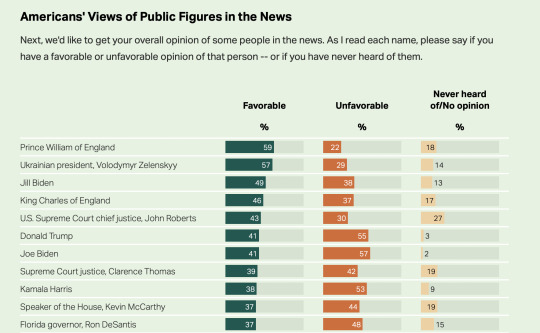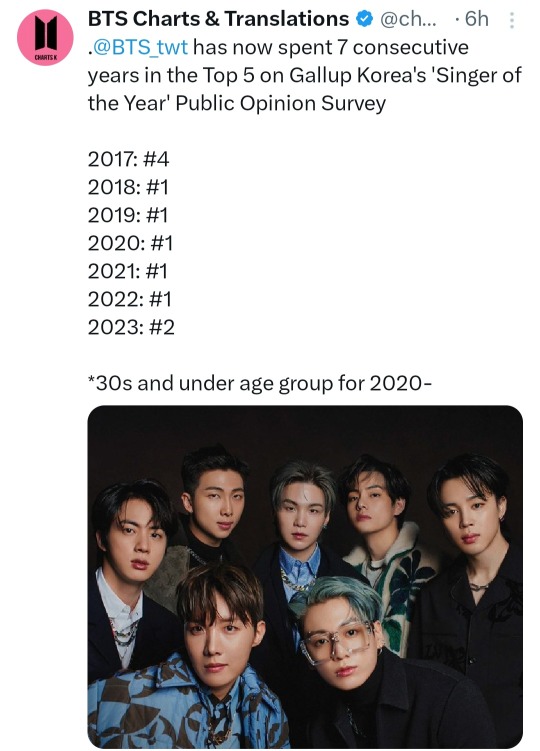#gallup poll
Text
Keep protesting, keep boycotting, and keep talking about Gaza. This headline (from March 27th) would have been unthinkable a few months ago.

#US news#gallup poll#gaza#palestine#we have already seen the political rhetoric begin to shift#and if we keep it up we can make the policy shift
3K notes
·
View notes
Text
#us politics#news#2024#gallup poll#Israel#gaza#gaza strip#free gaza#palestine#free palestine#genocide#world politics#polls#idf
105 notes
·
View notes
Text

🇮🇱⚔️🇵🇸 🚨
U.S. OPINION SOLIDIFIES ON GAZA, AMERICANS DISAPPROVE OF "ISRAEL'S" WAR OF GENOCIDE
📈 Infographic published by Turkish news agency Anadolu News visualizing the results from the latest Gallup poll on U.S. opinion on the genocide in Gaza.
55% of Americans disapprove of "Israel's" attacks on the Gaza Strip, while only 36% of Americans approve of "Israel's" actions, and 9% have no opinion.
The poll also mentions that 74% of Americans say they are following the news of the Zionist's genocide "closely", while 27% say they disapprove of Biden's Middle East policy.
Additionally, only 18% of Democrats approve of Israeli actions, while 64% of Republicans still approve of the genocide, a decrease in support among Republicans over previous polls.
#source
@WorkerSolidarityNews
#gaza#gaza strip#gaza news#gaza war#gaza genocide#genocide in gaza#israeli genocide#us news#us politics#us opinion#gallup poll#united states#biden administration#joe biden#israeli occupation forces#israel#israel news#israeli occupation#palestine#palestine news#palestinians#politics#news#geopolitics#world news#global news#international news#war#breaking news#current events
113 notes
·
View notes
Text
“In Search of...” with Leonard Nimoy, 1977.
259 notes
·
View notes
Text

Today, majorities of all but two key subgroups -- Republicans (49%) and weekly churchgoers (41%) -- say gay marriages should be legally recognized.

The groups most in favor of legal same-sex marriage are the same found in previous years -- adults aged 18 to 29 (89%), Democrats (84%) and infrequent churchgoers (83%).
28 notes
·
View notes
Text
Navalny's Widow Addresses EU Lawmakers
Yulia Navalnaya has vowed to continue her husband’s work to fight for a “free Russia,” Credit: EPA
In the days following her husband Alexei Navalny’s death in a Russian prison colony on 16 February, Yulia Navalnaya has picked up his mantle as a prominent critic of President Vladimir Putin. Speaking to European lawmakers and students from across the continent in Strasbourg, Ms. Navalnaya called…

View On WordPress
#9M729 milliles (NATO classification: SSC-8)#Alexei Navalny#antisemitism#Arab Americans#Berlin#British Board of Film Classification#British Film Censors#CBO#CDU#CPAC#Disney#Donald Trump#Emmanual Macron#Eurasia Group#Evan Heerema#Friedrich Merz#Gallup poll#Gaza#Hamtramck#Hillary Clinton#immigration#Israel#James Cleverly#Jeremy Hunt#Jew hatred#Joe Biden#Kiev#Kyiv#Liberation Day#London
4 notes
·
View notes
Text
Younger people more likely to identify as LGBT
Gallup's poll on LGBT identity finds younger people are more likely to identify as LGBT.
These numbers are for US adults, and the statistics for residents of other countries could be different.

I find these numbers remarkable in both directions.
The number of Gen Z adults who identify as LGBT is stunningly large.
Simultaneously, I find the incredibly small numbers of LGBT identification among the Silent Generation and Baby Boomers surprising as well.
Millennials, at 9.8% LGBT, are the closest in size to the percent of US adults overall who identify as LGBT, 7.6%.
Gallup determined 19.7% of Gen Z adults identified as LGBT in 2022.
The percent of Gen Z adults who identify as LGBT has risen to 22.3% in 2023, an increase of 2.6%.
Gen Z saw the largest change of any generation compared to 2022.
I created a line graph, using Flourish, to visualize the percent of each generation that identified as LGBT in each of Gallup’s annual surveys since 2020.

Two interesting observations can be easily seen on this graph.
First, in each annual survey, the generational pattern holds. Each younger generation has a higher LGBT value than the one that came before.
Second, the value for US adults overall is always between the values for Millennials and Gen X.
Here is the table of the values used to create the line graph above.

You can learn more about the results of Gallup's LGBT poll on my blog, Meticulous Musings.
@gendercensus
3 notes
·
View notes
Link
By: Frank Newport
Published: Jul 6, 2022
WASHINGTON, D.C. -- A record-low 20% of Americans now say the Bible is the literal word of God, down from 24% the last time the question was asked in 2017, and half of what it was at its high points in 1980 and 1984. Meanwhile, a new high of 29% say the Bible is a collection of "fables, legends, history and moral precepts recorded by man." This marks the first time significantly more Americans have viewed the Bible as not divinely inspired than as the literal word of God. The largest percentage, 49%, choose the middle alternative, roughly in line with where it has been in previous years.

Interpretation of the Bible, the holy Scripture of the Christian religion, has varied widely across time and across religious traditions. Gallup has been asking Americans specifically about their views on a literal interpretation of the Bible since 1976, with the latest update coming in Gallup's May Values and Beliefs survey.
The shift in attitudes about the Bible is not an isolated phenomenon. It comes even as a number of indicators show a decline in overall religiosity in the U.S. adult population. These measures include declines in formal identification with a religion, self-reported membership in a church, self-reported religious service attendance, personal importance of religion, and a decline in belief in God. Thus, it is not surprising to find that views on the nature of the Bible have shifted in a less religious direction as well.
The accompanying graph displays the recent trend in the percentage of Americans who choose a biblical literalist interpretation and the percentage who say religion is very important in their lives. These attitudes are closely related (the statistical correlation is .86) and underscore the conclusion that trends in Americans' attitudes about most aspects of religion tend to cluster together.
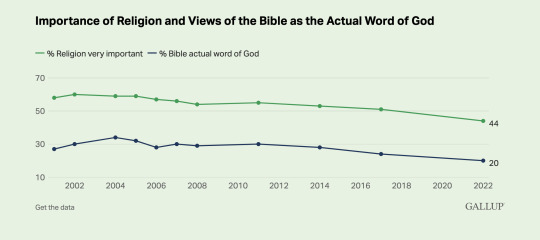
Protestants Most Likely to View Bible as Literally True
Gallup's biblical literacy question is asked of the entire U.S. adult population. This includes people who identify with religions outside of the Christian tradition -- about 9% of adult Americans in Gallup's latest estimates. Plus, the sample includes those who do not have any specific religious identity at all, almost all of whom do not believe that the Bible is literally true.
The accompanying table displays the views of Americans who identify as Christians and those who do not. The differences are in the expected direction, although the underlying pattern of responses remains similar to that of the general population. The majority of Christians (58%) say the Bible is the inspired word of God but not everything in it is to be taken literally, while 25% say it should be interpreted literally and 16% say it is an ancient book of fables.

More granularly, 30% of Protestants say that the Bible is literally true, compared with 15% of Catholics. Almost two-thirds of Catholics choose the alternative that the Bible is the inspired word of God, but every word should not be taken literally.
As was the case in 2017, belief in a literal Bible is highest among those who are more religious and among those with less formal education. Americans who identify as evangelical or born again are much more likely than others to view the Bible as literally true, although even among this group, the percentage believing in a literal Bible is well less than 50%.

Bottom Line
The issue of how to interpret the Bible has been a subject of debate since the first words of what became the Old Testament were written down centuries before the birth of Christ. In more recent years, various religious leaders and religious entities have staked out positions on the Bible that they claim define truth and that, in turn, have become an integral part of their religious positioning. The most prominent of these positions is the belief that the Bible is inerrant and must be viewed as literally true, a position adopted as part of the evangelical movement in this country over the past centuries and by a number of Protestant denominations.
At this point, a declining proportion of the overall American population -- now 20% -- believes the Bible is literally true, word for word. About half believe that the Bible is the inspired word of God, but not everything in it should be taken literally, while almost three in 10 say the Bible is an ancient book of fables and history. Belief in a literal Bible is declining, part of a general pattern of declining religiosity among the adult American population.
Americans' interpretations of the Bible are important, because the Bible is often used as the basis for policy positions on moral and values issues, including such things as abortion and gay and lesbian relations. Some more conservative Protestant groups use a literal interpretation of passages from the New Testament as the basis for their belief that women should not be in positions of religious leadership in churches. Gallup's data show that the use of a literal interpretation of the Bible as the basis or justification for social policy positions will likely resonate only with a declining minority of the overall U.S. population.
==
How true can Xianity even be if, millennia later, they still can’t figure out what it is?
If Xians themselves decide what’s true and what’s not, how can they keep insisting that it is true, and worse, how is anyone else supposed to be convinced? Especially given the god of a book of metaphors is unavoidably also a metaphor.
#Gallup Poll#bible#christianity#bible study#fiction#terrible fiction#bible fables#fables#religious fables#fairytales#bible fairytales#literal word of god#metaphorical god#metaphor#god is metaphorical#it's a metaphor#religion#holy bible#religion is a mental illness
25 notes
·
View notes
Text

Always remember and never forget -- when you hear the results of a poll or survey --
Exactly how the question is WORDED makes all the difference, every time! 🤔
6 notes
·
View notes
Text
Young women are more likely to identify as liberal now than at any time in the past two decades, a trend that puts them squarely at odds with young men.
44% of young women counted themselves liberal in 2021, compared to 25% of young men, according to Gallup Poll data analyzed by the Survey Center on American Life. The gender gap is the largest recorded in 24 years of polling. The finding culminates years of rising liberalism among women ages 18 to 29, without any increase among their male peers.
Several societal forces have conspired to push young women to the left in recent years, including the #MeToo movement, former President Trump, rising LGBTQ identification and, most recently, abortion policy. Slower-cooking trends in marital status and educational attainment have also nudged the needle.
“I think there is a big generational shift that happened with Generation Z women who were really coming of age in the last five years,” said Kelsy Kretschmer, a sociologist at Oregon State University who studies gender politics.
The rift between young men and women may widen further. Earlier this year, the Supreme Court overturned Roe v. Wade, a precedent that had protected abortion as a constitutional right for nearly half a century. The ruling has energized young women. New survey data, released this week, shows that 61% of young women consider abortion a critical issue, compared with 36% of all Americans.
“I would always choose a candidate that’s pro-abortion,” said Rose Merjos, 21, a government major at Wesleyan University in Connecticut who is an avowed liberal. “Almost everyone either knows someone who has had an abortion or has had one themselves. This is something everyone can relate to.”
The share of men who identify as liberal has held fairly steady for almost 25 years, according to annual Gallup surveys. Roughly one-quarter of men ages 18 to 29 term themselves liberal, year after year.
Meanwhile, among young women, liberalism has exploded. In the late 1990s and early 2000s, fewer than 30% of women identified as liberal. The liberal camp grew through the second term of former President George W. Bush. It expanded further during the tenure of former President Obama. It reached 39% in 2017 with the inauguration of Trump. In the last two years, liberalism surged anew.
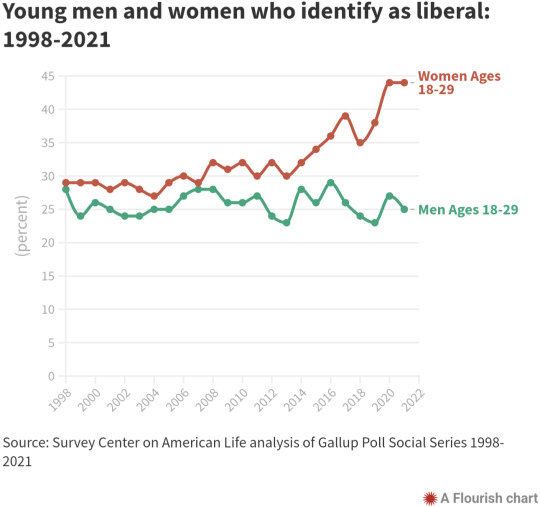
“Young women today are much more liberal than young men,” Daniel Cox wrote in a June newsletter of the Survey Center on American Life, a project of the American Enterprise Institute. His work documents “a growing political rift” between young women and men.
Merjos attends a university long associated with both liberalism and activism. These days, though, she senses more of both among the women.
“In all of my government classes, there are probably two men out of 18 people,” she said. “ACLU [American Civil Liberties Union], that’s mostly women. I’m wondering if women are maybe just more inclined to be involved in the community, engaged in the community. And that liberalizes them.”
Ezra Meyer, 22, is a senior at the George Washington (GW) University who leads the College Republicans. He is a conservative on a campus that is overwhelmingly liberal and largely female. In conversations with classmates about politics, he treads lightly.
“My metric for deciding if I’m going to be friends with someone really does not come down to what their politics are,” he said. “It comes down to how tolerant they are.”
Meyer doesn’t know whether the men at GW skew more liberal or conservative than the women. But he has noticed a distinct trend among campus conservatives this fall.
“We’ve been doing a lot of recruiting of freshmen on campus,” he said. “And I would say, overwhelmingly, it has been male. The conservative females that do get involved, there’s fewer of them, but they tend to be way more passionate and way more involved.”
Several factors have liberalized the nation’s 20-something women. The most recent, and perhaps the most powerful, is #MeToo, an uprising against sexual assault, abuse and harassment that caught fire in 2017, empowering millions of women to come forward and seek justice.
The inauguration of Trump in the same year pushed more young women into the liberal column. The 45th president battled his own #MeToo allegations and proved uniquely unpopular among young, female voters. Polling in 2016 showed that only 25% of women ages 18 to 34 favored Trump, compared with 40% of same-aged men.
The rise of liberalism among young women has also marched apace with a dramatic increase in young people identifying as lesbian, gay, bisexual, transgender or queer. In a recent survey, 56% of young women reported exclusive attraction to men, while three-quarters of young men said they were solely attracted to women. Prior research suggests LGBTQ Americans of all ages trend toward liberalism.
Several longer-term trends have fed the liberalization of young women as well. One is marriage. The share of women ages 18-29 who are married has fallen by half in twenty years, from 31% in 2000 to 15% in 2021, according to the National Opinion Research Center.
The growing ranks of single, 20-something women feel a sense of “linked fate,” researchers say. They gravitate toward female friends in political views, whereas married women more often mirror the politics of their spouses.
“The correlation between women’s sense of linked fate and liberal political preferences suggests that the Democratic Party will benefit” from declining marriage rates among young women, Kretschmer and two co-authors wrote in a 2017 paper for the journal Political Research Quarterly. They noted that “women make up the majority of the population and vote at high rates.”
Women also outpace men in educational attainment, a trend that dates to the 1980s. The ratio of women to men in college enrollment now stands at roughly 60 to 40, and it continues to grow. Americans who complete college are more liberal than those who do not.
“Putting off marriage, going to college, entering the workforce, women are doing that at much higher rates than they used to,” said Marc Hetherington, a professor of political science at the University of North Carolina at Chapel Hill. “And all of those things are going to make conservatism and the Republicans significantly less attractive to women.”
In 1998, the first year of data collected by Gallup in its Social Series surveys, 28% of young men and 29% of young women identified as liberal. The gender gap in liberalism grew steadily wider in the 2000s, wider still in the 2010s. The 2021 poll yielded a 19-point spread between young men and young women, the largest on record.
“I do have some male friends that are moderate,” said Luci Paczkowski, 20, a California liberal. “And it annoys the hell out of me.”
What bothers Paczkowski about her nonliberal friends is not their centrism but her suspicion that they “do not have any clue why they are moderate. They just do not want to pick a side and, therefore, they are apathetic.”
#us politics#news#the hill#2022#liberals#liberalism#Democrats#polls#polling#Survey Center on American Life#Gallup Poll#conservatives#conservatism#republicans#graphs#data#National Opinion Research Center
363 notes
·
View notes
Link
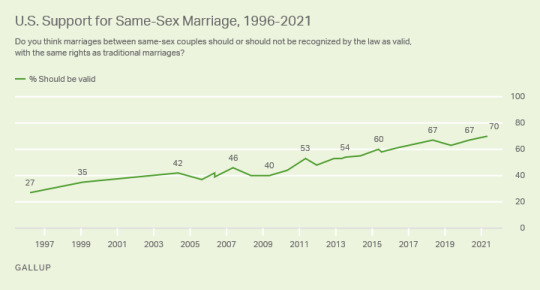


26 notes
·
View notes
Text
Anti-China Narrative Psychological Projection of US
— By S.L. Kanthan | February 08, 2024
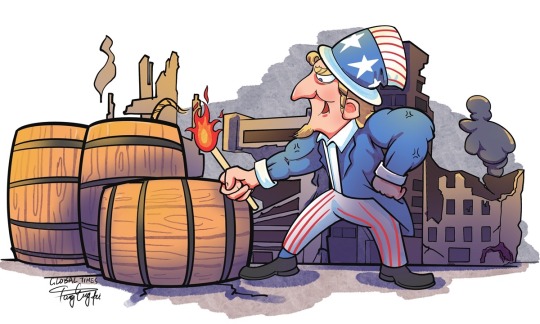
Illustration: Tang Tengfei/Global Times
The US has struggled with a congenital defect - its addiction to wars. President John Quincy Adams famously said, "America does not go abroad in search of monsters to destroy." However, history tells a very different story, with the US having spent about 94 percent of the time in wars since 1776. The American Empire now has 800 military bases in 140 countries, and keeps doubling down on perpetual wars. Not satisfied with the current proxy and real wars in Ukraine, Gaza, Yemen, Lebanon, Iraq, Syria - and possibly Iran soon - the cackle of American think tanks and corporate media is clamoring for a delusional hot war against China.
The narrative against China can only be described as psychological projection. Using twisted logic and fallacies, the China hawks scream that China is a threat to the US and the world. But they forget to mention that the US has been waging non-stop economic war and propaganda war against China for years. Also, it is the US that surrounds China with hostile military bases - building new ones in the Philippines. Yet, in the world of inversion, China is the bad guy.
The US tries to hobble China's economy in countless ways, and then claims that China's slower GDP growth - relative to China's past performance, but still much better than the G7 nations - is an indication of China's intent to "invade Taiwan."
From Monday through Wednesday, US media gloats that China is collapsing. And Thursday through Sunday, the same media cries that China is on the cusp of taking over the world. Which one is it - China is weak or omnipotent?
Another popular talking point among anti-China hardliners is the rapid growth in China's defense investment. China's military strategy is mostly defensive like the Great Wall. China is a "threat" only to rapacious invaders.
As for Taiwan, here is the bitter pill for imperialists: there will be reunification. When China was weak in the 19th century, it was attacked by vultures who plucked off strategic regions. However, as China regained its rightful position in the world, former colonialists retreated, giving back the stolen lands. Remember how Portugal returned Macau and the UK returned Hong Kong? Similarly, the US will one day let go of Taiwan. The sooner the Americans accept this inevitability, the better the world will be.
"America Does Not Go Abroad in Search of Monsters To Destroy." — President John Quincy Adams
There was a time when one could tell the difference between a sensational tabloid and serious journalism in the US, but not anymore. Now, the once respectable media outlets such as the New York Times and Wall Street Journal are filled with fake news, disinformation and war propaganda.
A recent article by Hal Brands in Foreign Policy is an exemplary case for this decline in American intellectualism. By the way, Mr. Brands has stellar credentials - educated at Stanford and Yale, author of numerous books, and a regular columnist. However, his article is filled with misinformation and sensationalism. Lacking any real evidence of "China threat," he quotes the CIA, the organization that lies, cheats and steals - to paraphrase Mike Pompeo, former CIA director.
Finally, Hal Brands' entire premise about the state of China's economy is deeply flawed. In his echo chamber, nobody talks about China's 5.2-percent GDP growth in 2023, a trade surplus of a staggering $800 billion, China becoming the world's #1 exporter of cars, BYD surpassing Tesla, the resurgence of Huawei, and a long list of other accomplishments.
China watchers have been wrong for long but nobody gets fired for being wrong about China. Why? The goals of incessant big lies are to convince Americans that they have the greatest economic and political systems, and to manufacture consent for a war against China. Sadly, the propagandists are quite successful - the number of Americans who view China favorably dropped from 53 percent in 2018 to 15 percent by 2023 (Gallup Poll).
This is not the old Cold War. Today, the US economy is intricately linked to and dependent on China. From Apple and Tesla to Walmart and Starbucks, American corporations' fortunes depend on Chinese workers and consumers. Even the US military cannot function without Chinese products - for example, the CEO of Raytheon admitted that his company relies on "thousands of Chinese suppliers." Decoupling is a pipe dream.
US elites need a grand reset in their understanding of the world. A multipolar world is emerging. The US needs to stop being the "most warlike nation in history of the world," as Jimmy Carter put it. It's time to discard the paradigms of the military-industrial complex, and instead embrace a future of multilateralism, development and peace.
— The Author is a Geopolitical Analyst, Columnist, Blogger, Podcaster, and Writer Based out of Bangalore, India. His work can be found on Substack, X and more.
#China 🇨🇳#United States 🇺🇸#Anti-China 🇨🇳 Narritive#Psychological Projection#S.L. Kanthan#Global Times#Hal Brands | Foreign Policy | Decline | American intellectualism#Gallup Poll#CEO | Raytheon#Chinese Supplies
0 notes
Text
Transgender, Bisexual, and Lesbian identities become more common in latest poll
The percent of US adults who identify as Bisexual, Lesbian, and Transgender has increased, according to a new Gallup poll.
The percent of US adults who identify as gay has remained the same.
Bisexual identity among US adults in 2023 increased by 0.2%, compared to the year before.
Lesbian also increased by 0.2%.
Transgender increased by 0.3%.
Here are the percent of US adults who identified with specific LGBT identities in 2023, according to Gallup.
Identity US adults
Bisexual 4.4%
Gay 1.4%
Lesbian 1.2%
Transgender 0.9%
The following table shows the percent of US adults who identified with specific LGBT identities in Gallup’s annual survey for the past four years.

I created a line graph, using Flourish, to illustrate this data.

The percent of US adults who identify as LGBT appears to track fairly well with the values for bisexual.
Here is a version of the graph that only shows specific LGBT identities.
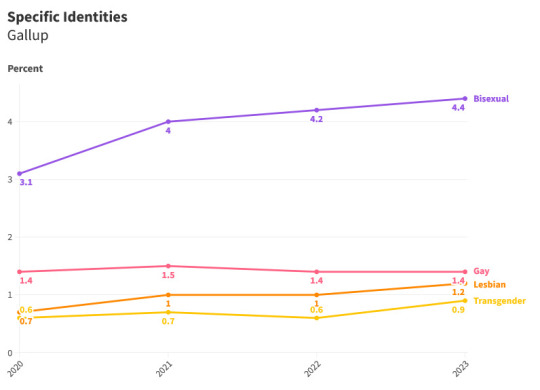
As you can see, the order of identities remains consistent. Bisexual is always the largest, followed by Gay, Lesbian, and Transgender, in that order.
You can learn more about the statistics regarding LGBT identity in the US on my blog, Meticulous Musings.
2 notes
·
View notes
